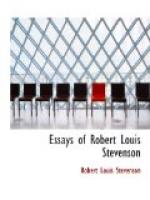Lamb, to Wordsworth, to Sir Thomas Browne, to Defoe,
to Hawthorne, to Montaigne, to Baudelaire and to Obermann.[3]
I remember one of these monkey tricks, which was called
The Vanity of Morals: it was to have had
a second part,
The Vanity of Knowledge; and
as I had neither morality nor scholarship, the names
were apt; but the second part was never attempted,
and the first part was written (which is my reason
for recalling it, ghostlike, from its ashes) no less
than three times: first in the manner of Hazlitt,
second in the manner of Ruskin,[4] who had cast on
me a passing spell, and third, in a laborious pasticcio
of Sir Thomas Browne. So with my other works:
Cain, an epic, was (save the mark!) an imitation
of
Sordello: Robin Hood, a tale in verse,
took an eclectic middle course among the fields of
Keats, Chaucer and Morris: in
Monmouth,
a tragedy, I reclined on the bosom of Mr. Swinburne;
in my innumerable gouty-footed lyrics, I followed
many masters; in the first draft of
The King’s
Pardon, a tragedy, I was on the trail of no lesser
man than John Webster; in the second draft of the
same piece, with staggering versatility, I had shifted
my allegiance to Congreve, and of course conceived
my fable in a less serious vein—for it was
not Congreve’s verse, it was his exquisite prose,
that I admired and sought to copy. Even at the
age of thirteen I had tried to do justice to the inhabitants
of the famous city of Peebles[5] in the style of the
Book of Snobs. So I might go on for ever,
through all my abortive novels, and down to my later
plays,[6] of which I think more tenderly, for they
were not only conceived at first under the bracing
influence of old Dumas, but have met with, resurrections:
one, strangely bettered by another hand, came on the
stage itself and was played by bodily actors; the
other, originally known as
Semiramis: a Tragedy,
I have observed on bookstalls under the
alias
of
Prince Otto. But enough has been said
to show by what arts of impersonation, and in what
purely ventriloquial efforts I first saw my words on
paper.
That, like it or not, is the way to learn to write;
whether I have profited or not, that is the way.
It was so Keats learned,[7] and there was never a
finer temperament for literature than Keats’s;
it was so, if we could trace it out, that all men
have learned; and that is why a revival of letters
is always accompanied or heralded by a cast back to
earlier and fresher models. Perhaps I hear someone
cry out: But this is not the way to be original!
It is not; nor is there any way but to be born so.
Nor yet, if you are born original, is there anything
in this training that shall clip the wings of your
originality. There can be none more original than
Montaigne,[8] neither could any be more unlike Cicero;
yet no craftsman can fail to see how much the one
must have tried in his time to imitate the other.
Burns[9] is the very type of a prime force in letters:




